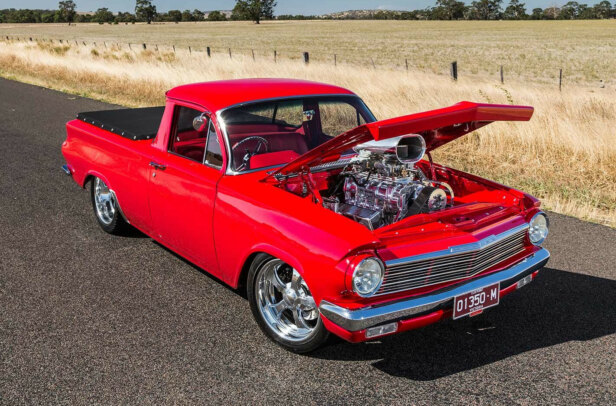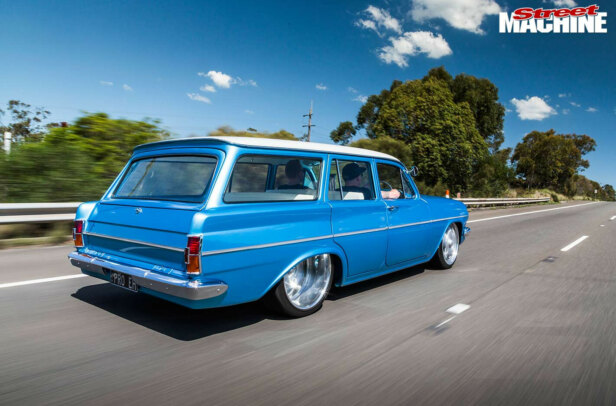Do we ever finish our cars? Sometimes we say they’re finished but then we still insist on tinkering with a perfectly good vehicle. It’s the nature of what we are.
Shane Keene’s EH van was finished, or so we thought, back before Summernats 17 and we featured it in the Nov ’04 edition of Street Machine. Back then Shane did warn us that there might be more to come.
First published in the June 2006 issue of Street Machine

“Truth be told,” he said at the time, “I’d really love to put a blower on the van.”
So Shane bought his blower and plonked it on the mild 327 that was already under the bonnet.
“I just wanted to change the look of it — I’ve always liked the look of 6/71-blown Chevs.”
Unfortunately — let this be a lesson to budding street machiners — the engine didn’t last too long under that polished mountain of metal.

Four pistons let go together, with detonation smashing the piston crowns and ring lands. While you might hear plenty of stories of guys using blowers on near stock motors, it takes a light touch and some good tuning for these sorts of combos to last. How did Shane kill his?
“I was doing a burnout in the shed. I took it for a run up and down the road, my brother and I were mucking around, and then it started blowing smoke after that.”
This was around the time of Springnats 2005, so Shane had a talk with engine guru Wayne Bennett.

“He reckoned we’d had done a piston. It turned out to be four pistons, all on the passenger side,” Shane says.
The aim had been to take the newly blown van back to Summernats where the green EH has won Top Van in the Street category twice.
With a dead engine and Summernats looming, Wayne took on the job of rebuilding the blown 327 Chevy small-block. Out came the dud slugs and in went a set of shiny new 30-thou over TRW forgies, dropping the squeeze to a boost-friendly 8:1 compression. Stock rods and steel crank completed the bottom end while the top was sealed with a pair of mildly ported cast-iron heads. Nothing outrageous, just good, solid components to handle the rigours of boost.

Up the guts there’s a custom Crow cam designed to work with the Weiand 6/71 blower that’s topped by a pair of 600 double pumper Holleys. With the blower running five per cent under-driven, it pumps around 13psi into the 327-cube small-block. Exhaust gases are dumped through a custom set of coated headers and a twin three-inch system that Shane built from the headers back.
Besides the addition of the blower, the rest of the van is pretty much the same as last time we saw it. The outside painted in lavish custom Keene Green and the inside trimmed in biscuit-coloured leather with Mercedes carpet.
“I didn’t think it was going to get to Canberra — a lot of late nights and we got it there though,” says Shane.

The blown van certainly had the impact he was hoping for: “I was going to enter the Street Class but the judges talked me into going Elite.”
That’s despite the fact that the EH isn’t heavily detailed underneath; in fact it’s just painted gloss black on the downside because until recently Shane lived on a dirt road. To prove that fairy tales do come true, the EH won Top Van in the Elite category as well as a place in the Top 60, showing that it has what it takes at the sharp end of competition, despite being a true street car. Yep, Shane drives it to work sometimes and he loves to cruise to swap-meets and shows around the area.
That’s not where it’s gonna stop however, because Shane now wants to know if the van has the goods on the strip. Yup, close your mouths, he’s actually gonna take this beauty down the big black dyno and test it against the clock.

And why not? After all, the tubs at the back house a pair of 12.5inch-wide Mickey Thompson Sportsman tyres and Shane’s changed the cogs in the nine-inch diff to a set of 3.25 gears, from the old 2.75s that were in there for maximum cruiseability. The stall speed has been upped to 2800rpm for better launches.
It’s not all about the strip though; there are plans for more detailing underneath now the cool shaggin’ wagon has proven itself in the Elite hall, and there’s still plenty more cruising to do. Whatever Shane does, we know he’ll do it well and with three EHs in the garage and a couple more projects planned he’s got a busy time ahead.

CARBS OR EFI?
You may wonder why many serious car builders like Shane stick with the traditional pair of Holley carbies on their blown V8s. Surely EFI systems have progressed to the point where carbs are obsolete?
The answer lies in the ancient design of the still-awesome GM supercharger. Unlike more modern positive displacement units (such as screw or Eaton-type pumps), you have to run fuel through the GM blower or you’ll hurt it. A GM blower uses fuel to help seal the clearance between the rotor tips and the case, and it also cools the rotors so they don’t expand and hit the case.
This limitation effectively reduces EFI GM blower set-ups to the status of an electronic carby. Why? Since the fuel is injected above the blower, it isn’t being aimed directly at individual intake ports and is forced into a common plenum area under the blower. Some have described it as a big washing machine where fuel and air are churned around by the blower rotors, and this means you lose the fine tune-ability of a typical EFI system. Running extra injectors straight into the intake manifold isn’t really an option as there isn’t enough room beside the blower. Drag cars are able to run injector lines above and below the blower because methanol injector lines are’t as thick as EFI squirters.

Theoretically you could space the blower up and squeeze injectors down beside it and then run a few injectors (say four) above the blower but you still can’t get away from the washing machine effect.
Benefits of a well-tuned GM blower set-up with EFI include the fact that you can tune the ignition maps and temperature-based fuel compensation. Whether that’s worth the extra expense is up to you and your tuner.
SHANE KEENE
1964 EH PANELVAN
| Colour: | Spies Hecker custom Keene Green |
| GRUNT | |
| Engine: | Chev 327 |
| Blower: | Weiand 6/71 |
| Carbs: | Twin Holley 600DP |
| Manifold: | Weiand blower |
| Heads: | Ported cast-iron |
| Pistons: | TRW forged, 8:1 |
| Crank: | Steel |
| Cam: | Crow solid |
| Ignition: | Twin Point dizzy |
| Exhaust: | Custom headers, twin three-inch system |
| SHIFT | |
| Transmission: | Turbo 350, stage two shift kit |
| Converter: | 2800rpm stall |
| Diff: | Nine-inch, 3.25 gears |
| BENEATH | |
| Brakes: | HQ discs (f), VN discs (r) |
| Suspension: | HR Holden, two-inch drop spindles (f), leaf springs relocated inboard (r) |
| Springs: | HR heavy-duty lowered (f) reset five-inch lowered leaves (r) |
| Shocks: | Pedders (f&r) |
| Steering: | Torana rack & pinion |
| Bushes: | Nolathane |
| INTERIOR | |
| Tiller: | Billet Specialties Thrasher |
| Seats: | VN Commodore in biscuit leather |
| Gauges: | Auto Meter boost & temp |
| Stereo: | Pioneer CD, 6.5-inch speakers |
| Shifter: | B&M Megashifter |
| ROLLING | |
| Rims: | Weld Pro Star, 15×5 (f), 15×10 (r) |
| Rubber: | Hankook 165/65 (f), M/T Sportsman 15×12.5 (r) |
THANKS
Di (mum), Tony (brother), Jacko (sister-in-law), Wayne Bennett, Kim Tuohey, John & Lyn Kerr at Bodyline Automotive, Bendigo Trim, Bendigo Radiators, Beeps Autopro, Graham Laity for the headers and Trev Monty for the paint.




Comments